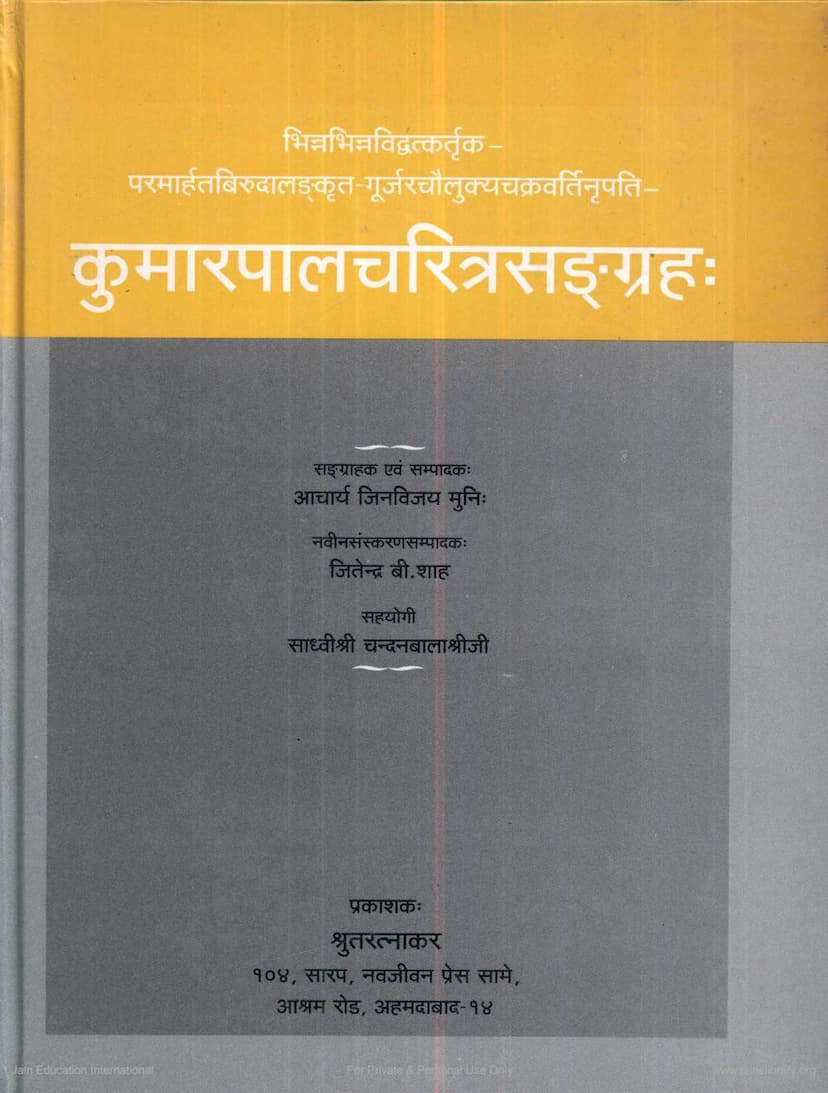Kumarpalcharitrasangraha New Publication Of Shrutaratnakar
Added to library: September 2, 2025

Summary
Here's a comprehensive summary of the Jain text "Kumarpalcharitrasangraha New Publication of Shrutaratnakar" by Jinvijay, published by Singhi Jain Shastra Shiksha P7, Mumbai, based on the provided pages:
Title: Kumarpalcharitrasangraha (A Collection of Narratives on the Life of Kumarpala)
Author/Compiler: Acharya Jinvijay Muni
New Edition Editor: Jitendra B. Shah
Collaborator: Sadhvi Shri Chandanbalashriji
Publisher: Shrutaratnakara 104, Sarang, Navjivan Press Sāme, Ashram Road, Ahmedabad-14
Publication Details:
- Year: V.S. 2064 / 2006 AD
- Copies: 500
- Price: Rs. 400/-
- Organized by: Sharda Ben Chimnabhai Educational Research Centre, Ahmedabad.
Core Content and Themes:
The book is a collection of various accounts detailing the life and deeds of King Kumarpala, a prominent ruler of Gujarat during the Solanki (Chaulukya) dynasty. The text highlights Kumarpala's significance as a righteous and just king, often referred to by the title "Paramarhat" (one who has attained the highest spiritual state).
Key Aspects Highlighted:
-
Golden Age of Gujarat: The Solanki era, particularly the reigns of Siddharaj Jaysingh and Kumarpala, is described as the "Golden Age of Gujarat." Both rulers brought prosperity, expanded the kingdom, and fostered progress in various fields.
-
Influence of Acharya Hemchandrasuri: A central theme is the profound influence of the renowned Jain scholar and monk, Acharya Hemchandrasuri (also known as Kalikala Sarvajna), on King Kumarpala.
- Hemchandrasuri inspired Siddharaj Jaysingh to undertake many public welfare projects.
- Hemchandrasuri's grammatical work, "Siddhahemashabdānushasana," including its chapter on Prakrit grammar and the first grammar of Old Gujarati (Apabhramsha), is mentioned as a significant contribution.
- Kumarpala considered Hemchandrasuri his guru and, under his guidance, embraced various vows and principles of Jainism.
- Hemchandrasuri guided Kumarpala in both royal duties (Rajdharma) and personal conduct (Jeevanadharma), leading him towards spiritual welfare.
-
Kumarpala's Embrace of Jainism and Ahinsa:
- Kumarpala, inspired by Hemchandrasuri, became a devout follower of Jainism.
- Upon gaining power, he vigorously promoted the principle of Ahinsa (non-violence) throughout his kingdom, banning animal sacrifice and advocating for the protection of all living beings for twelve years.
- This emphasis on Ahinsa is credited with deeply embedding Jain principles in Gujarat, making the region renowned for Ahinsa even today.
- Kumarpala's adoption of Jainism led him to achieve the title "Paramarhat," signifying his spiritual attainment.
-
Historical and Literary Significance:
- The book emphasizes that Kumarpala's life and achievements were documented by contemporary and later Jain scholars in various Prākrit, Sanskrit, and vernacular texts.
- The collection aims to compile these accounts, many of which were previously obscure or unavailable, to benefit researchers and the curious public.
- The current edition is a re-publication of a collection previously compiled by Muni Jinavijayji through the Singhi Jain Granthamala.
-
Challenges in Re-publication:
- The editor, Jitendra B. Shah, notes that when Muni Jinavijayji first published the collection, he received additional manuscripts that could not be incorporated due to the advanced stage of printing. These variations were appended.
- Revisiting and re-editing the original text based on these variations was a significant undertaking, likened to "re-cooking cooked food."
- Sadhvi Shri Chandanbalashriji's dedicated and meticulous effort in the re-editing and refinement process is highly praised, especially considering her delicate health. Her contribution is described as invaluable.
-
Financial Support:
- The publication of this valuable ancient text was made possible by the generous financial support from the Shravak community and the Gyan Department of the Shri Jain Shvetambar Murtipujak Gujarati Panch, Malegaon, inspired by the guidance of Shri Naybhadra Vijay Maharaj.
-
Content of the Collection:
- The book comprises several 'prabandhas' or narratives about Kumarpala. The summary specifically mentions the inclusion of:
- An Ancient Brief Biography of Kumarpala: Attributed to an unknown author, this is a concise account of Kumarpala's pre-royal life. It details his extensive reign over a vast territory and his eventual attainment of heaven after worshiping Jinendra. in
- Kumarpaldevcharita by Acharya Somtilak Suri: This work, composed in the late 14th century Vikram Samvat, is considered an ideal source. The second edition's editor, Jitendra B. Shah, details the textual variations and the use of multiple manuscripts (A, B, C) in its compilation. The text provides a chronological overview of Kumarpala's life, including his pre-royal struggles, military campaigns, administrative reforms, and religious practices. It also notes unique details not found elsewhere, such as his battle with the Mahamandalika Kumar of Nagpur.
- Kumarpalprabodhaprambandha (or Kumarpalpratibodhaprambandha): This significant work, whose name is inferred from an introductory verse, is based on older manuscripts and is rich in historical information, teachings, and propaganda elements, aiming to enlighten the reader about Kumarpala's life and principles.
- Kumarpaldevprabandha from Chaturashitiprabandh: This narrative is sourced from a collection of 84 prabandhas, though the complete text is not available. It includes lesser-known incidents and details about Acharya Hemchandrasuri.
- Historical Essence from Kumarpalpratibodh by Somaprabhacharya: This is a compilation of the historical sections from Somaprabhacharya's extensive work on Kumarpala, originally composed in Prakrit. This work holds immense historical importance as Somaprabhacharya was a contemporary of Kumarpala and Hemchandrasuri.
- The book comprises several 'prabandhas' or narratives about Kumarpala. The summary specifically mentions the inclusion of:
-
Praise for Kumarpala and Hemchandrasuri: The text includes verses from various poets and scholars praising the virtues and profound influence of both Kumarpala and Acharya Hemchandrasuri, underscoring their roles in Gujarat's golden age and the propagation of Jain dharma.
In essence, the Kumarpalcharitrasangraha is a vital resource for understanding the historical, religious, and cultural landscape of Gujarat during the Solanki period, with a particular focus on the transformative impact of Jainism, embodied by Acharya Hemchandrasuri, on the benevolent ruler King Kumarpala. The re-publication ensures the availability of these crucial historical narratives for future generations.